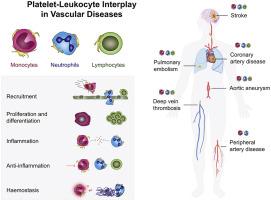当前位置:
X-MOL 学术
›
Atherosclerosis
›
论文详情
Our official English website, www.x-mol.net, welcomes your feedback! (Note: you will need to create a separate account there.)
Platelet-leukocyte interplay during vascular disease
Atherosclerosis ( IF 5.3 ) Pub Date : 2020-08-01 , DOI: 10.1016/j.atherosclerosis.2020.04.018 Waltraud C Schrottmaier 1 , Marion Mussbacher 2 , Manuel Salzmann 1 , Alice Assinger 1
Atherosclerosis ( IF 5.3 ) Pub Date : 2020-08-01 , DOI: 10.1016/j.atherosclerosis.2020.04.018 Waltraud C Schrottmaier 1 , Marion Mussbacher 2 , Manuel Salzmann 1 , Alice Assinger 1
Affiliation

|
Vascular disease is a progressive inflammatory condition fuelled by an unhealthy lifestyle of physical inactivity, cholesterol-rich diet, and smoking. Together with endogenous factors such as age, gender, and autoimmune status, an unhealthy lifestyle fosters a pro-inflammatory and pro-thrombotic milieu, which can lead to endothelial dysfunction, atherosclerotic plaque formation and vascular obstruction or degradation of the subendothelial matrix. Platelet-leukocyte interplay represents an important feature in this context. Platelets get activated in a pro-inflammatory and pro-thrombotic microenvironment and readily interact with innate and adaptive immune cells alike. Even though platelet affinity for physical cell-cell contact is highest with monocytes/macrophages and neutrophils, platelets also avidly interact with lymphocytes by soluble mediators. Platelet-leukocyte crosstalk regulates essential immune responses, supporting leukocyte recruitment at sites of vascular insult, promoting proliferation and differentiation of leukocytes and enhancing pro-inflammatory effector functions such as cytokine and reactive oxygen production. However, under certain conditions platelet-leukocyte interplay also dampens the inflammatory process. Crosstalk of platelet and leukocytes thus represents a driving force in vascular disease. In this review, we highlight the impact of various risk factors for vascular disease on platelet-leukocyte interactions and discuss the underlying mechanisms of platelet-mediated changes in immune responses and the effect of immune cells on the haemostatic system. As the underlying pathologies differ between vascular diseases, we summarize our current knowledge on platelet-leukocyte interplay in chronic vascular diseases such as abdominal aortic aneurysm, peripheral and coronary artery disease as well as acute vascular diseases such as ischaemic stroke and venous thromboembolism.
中文翻译:

血管疾病期间血小板-白细胞的相互作用
血管疾病是一种渐进的炎症性疾病,由不健康的生活方式、缺乏运动、富含胆固醇的饮食和吸烟所引发。与年龄、性别和自身免疫状态等内源性因素一起,不健康的生活方式会促进促炎和促血栓形成环境,这会导致内皮功能障碍、动脉粥样硬化斑块形成和血管阻塞或内皮下基质退化。在这种情况下,血小板-白细胞相互作用是一个重要的特征。血小板在促炎和促血栓形成的微环境中被激活,并且很容易与先天性和适应性免疫细胞相互作用。尽管血小板对单核细胞/巨噬细胞和中性粒细胞的物理细胞接触的亲和力最高,血小板还通过可溶性介质与淋巴细胞积极相互作用。血小板-白细胞串扰调节基本的免疫反应,支持血管损伤部位的白细胞募集,促进白细胞的增殖和分化,并增强促炎效应功能,如细胞因子和活性氧的产生。然而,在某些条件下,血小板-白细胞相互作用也会抑制炎症过程。因此,血小板和白细胞的串扰代表了血管疾病的驱动力。在这篇综述中,我们强调了血管疾病的各种危险因素对血小板-白细胞相互作用的影响,并讨论了血小板介导的免疫反应变化的潜在机制以及免疫细胞对止血系统的影响。
更新日期:2020-08-01
中文翻译:

血管疾病期间血小板-白细胞的相互作用
血管疾病是一种渐进的炎症性疾病,由不健康的生活方式、缺乏运动、富含胆固醇的饮食和吸烟所引发。与年龄、性别和自身免疫状态等内源性因素一起,不健康的生活方式会促进促炎和促血栓形成环境,这会导致内皮功能障碍、动脉粥样硬化斑块形成和血管阻塞或内皮下基质退化。在这种情况下,血小板-白细胞相互作用是一个重要的特征。血小板在促炎和促血栓形成的微环境中被激活,并且很容易与先天性和适应性免疫细胞相互作用。尽管血小板对单核细胞/巨噬细胞和中性粒细胞的物理细胞接触的亲和力最高,血小板还通过可溶性介质与淋巴细胞积极相互作用。血小板-白细胞串扰调节基本的免疫反应,支持血管损伤部位的白细胞募集,促进白细胞的增殖和分化,并增强促炎效应功能,如细胞因子和活性氧的产生。然而,在某些条件下,血小板-白细胞相互作用也会抑制炎症过程。因此,血小板和白细胞的串扰代表了血管疾病的驱动力。在这篇综述中,我们强调了血管疾病的各种危险因素对血小板-白细胞相互作用的影响,并讨论了血小板介导的免疫反应变化的潜在机制以及免疫细胞对止血系统的影响。



























 京公网安备 11010802027423号
京公网安备 11010802027423号